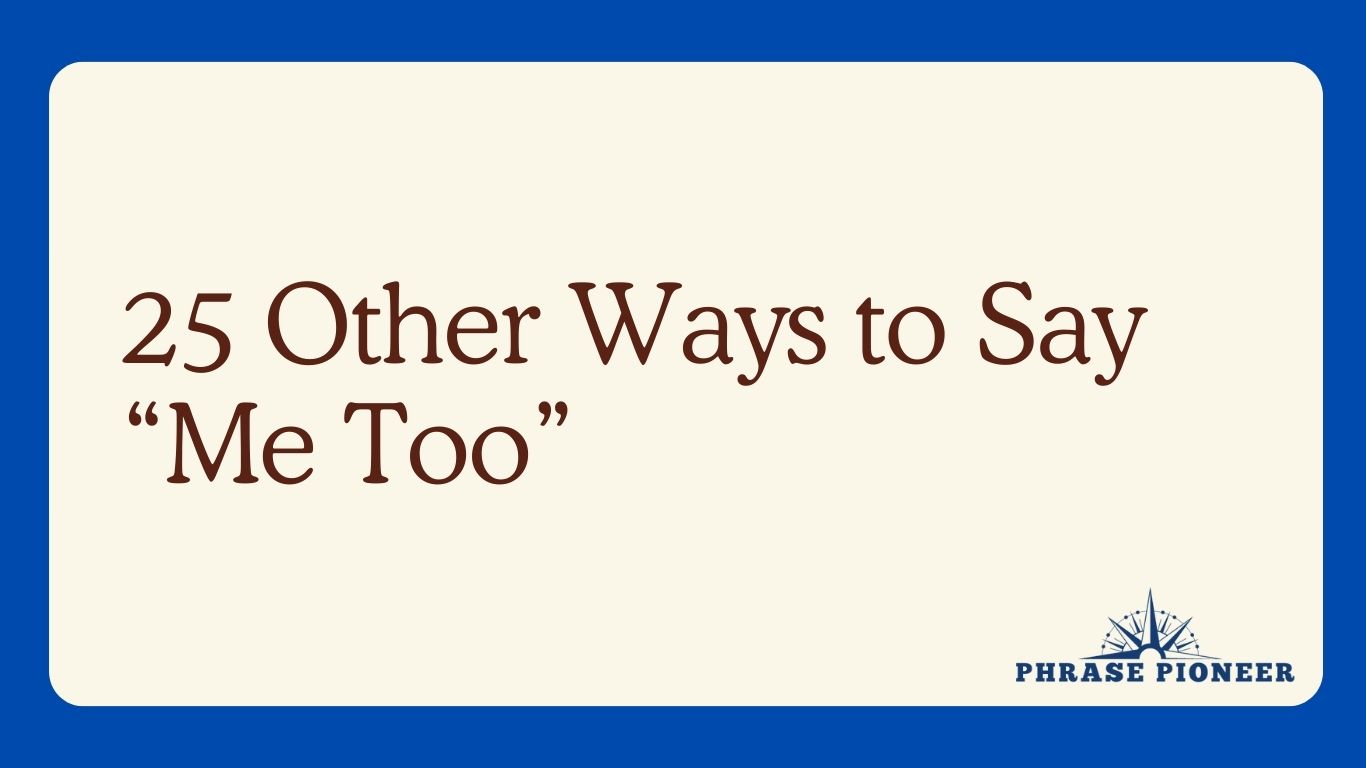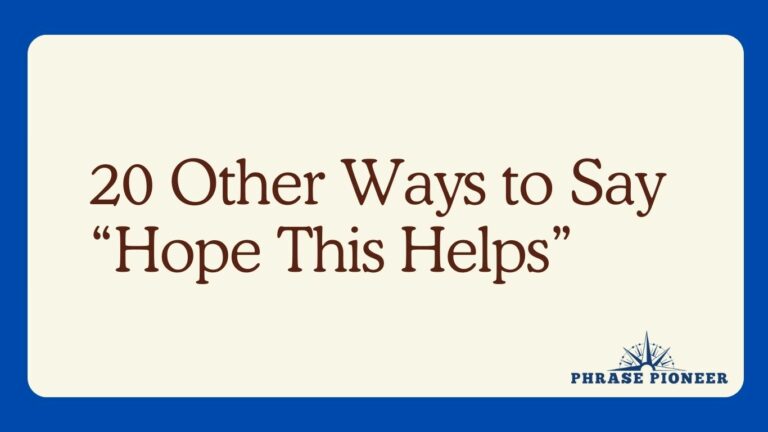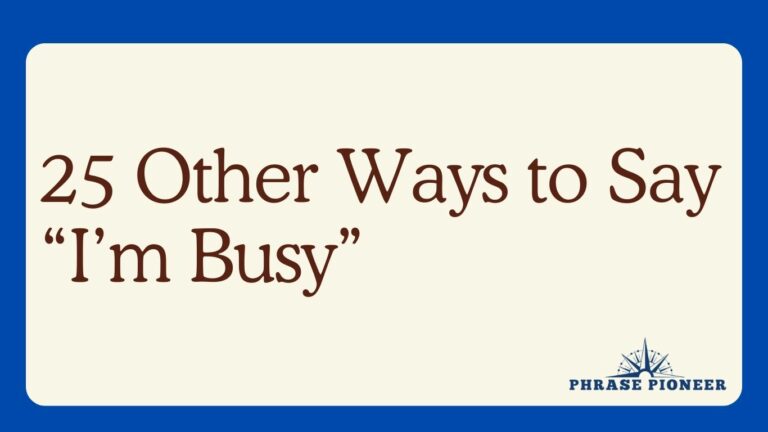25 Other Ways to Say “Me Too”
The phrase “Me too” is a common way to show agreement or shared experience.
Here are 25 alternative ways to say “Me too,” along with example sentences and explanations, to help you express your concurrence or solidarity in various contexts conversational nuances.
Expressions of Agreement:
1. “I feel the same way.”
- Example: “I really believe this is our best course of action.” “I feel the same way.”
- Explanation: Indicates that you share the same opinion or sentiment on a matter.
2. “Same here.”
- Example: “I find this weather to be quite delightful.” “Same here.”
- Explanation: A casual and succinct way of saying that you share the same opinion or experience.
3. “I agree completely.”
- Example: “Their latest album is their best yet.” “I agree completely.”
- Explanation: Conveys wholehearted concurrence with a previously stated opinion.
4. “So do I.”
- Example: “I love watching sunset over the beach.” “So do I.”
- Explanation: Echoes someone else’s statement, indicating you do the same thing or have the same preference.
5. “That’s true for me as well.”
- Example: “I find my morning yoga sessions essential.” “That’s true for me as well.”
- Explanation: Acknowledges that the same fact or habit applies to you.
Shared Experiences:
6. “I share the sentiment.”
- Example: “I think community events are vital for connection.” “I share the sentiment.”
- Explanation: Expresses that you have the same feeling or point of view.
7. “Ditto.”
- Example: “This town has the best coffee shops.” “Ditto.”
- Explanation: A colloquial and playful way of agreeing with someone, originated from the Latin “said” meaning “as said before”.
8. “Count me in on that.”
- Example: “I need to spend more time offline.” “Count me in on that.”
- Explanation: Implies you are joining in on an action or opinion.
9. “I concur.”
- Example: “We need more environmental awareness programs.” “I concur.”
- Explanation: A formal way to signify agreement with a statement or suggestion.
10. “I’m on the same page.”
- Example: “We should push the deadline back for more quality control.” “I’m on the same page.”
- Explanation: Shows that you are in agreement or harmony with the thought process or decision of someone else.
Expressions of Solidarity:
11. “I couldn’t agree more.”
- Example: “Education is key to improvement in society.” “I couldn’t agree more.”
- Explanation: Stresses the extent of one’s agreement, implying it isn’t possible to agree more strongly.
12. “I’m with you on that.”
- Example: “We need to prioritize self-care more often.” “I’m with you on that.”
- Explanation: Expresses support and agreement with a person’s opinion or stance.
13. “Likewise.”
- Example: “I always choose tea over coffee.” “Likewise.”
- Explanation: Indicates that you also prefer, choose, or do the same thing.
14. “Absolutely – me as well.”
- Example: “I hope to travel more once circumstances improve.” “Absolutely – me as well.”
- Explanation: Emphasizes agreement and adds your own desire into the mix.
15. “Very much so.”
- Example: “This city’s cultural scene is incomparable.” “Very much so.”
- Explanation: Shows a high degree of concordance with someone’s statement or judgment.
Confirming Shared Feelings:
16. “Just like me.”
- Example: “I tend to overthink when it comes to decision-making.” “Just like me.”
- Explanation: Indicating that what is true for the other person is also true for you, particularly in habits or personality traits.
17. “I have the same view.”
- Example: “Remote work has revolutionized our lives.” “I have the same view.”
- Explanation: Demonstrates that your opinion aligns with theirs on a particular issue.
18. “No different here.”
- Example: “I find that visiting art galleries stimulates my creativity.” “No different here.”
- Explanation: Reflects that your experiences or reactions mirror those of the other person.
19. “I second that.”
- Example: “These changes will improve our workflow.” “I second that.”
- Explanation: A standard way of formally expressing your agreement with a proposition or opinion.
20. “As do I.”
- Example: “I believe in constant learning.” “As do I.”
- Explanation: Affirming that what one person does or believes is the same for you.
Reflecting Agreement:
21. “I’m also of that opinion.”
- Example: “It’s high time we address these issues more openly.” “I’m also of that opinion.”
- Explanation: Conveys that your outlook or standpoint is identical to theirs.
22. “I echo that sentiment.”
- Example: “Creative collaboration is key to innovation.” “I echo that sentiment.”
- Explanation: Suggests a vocal affirmation, as if you are reflecting or repeating the same emotion or belief.
23. “Same goes for me.”
- Example: “I choose environmentally friendly products when I can.” “Same goes for me.”
- Explanation: Claims that the same action or choice occurs in your case as well.
24. “I’m of the same mind.”
- Example: “Quality should never be compromised for speed.” “I’m of the same mind.”
- Explanation: Suggests an agreement on a fundamental or philosophical level.
25. “That resonates with me too.”
- Example: “Music has the power to transcend boundaries.” “That resonates with me too.”
- Explanation: Indicates that the idea or emotion reverberates within you just as it does with the original speaker.
Each of these alternatives to “Me too” offers a nuanced way to convey agreement or shared experience.
They range from informal colloquialisms to formal affirmations of solidarity or intellectual accord, enabling you to match your response to the tone of the conversation and the nature of the relationship.







